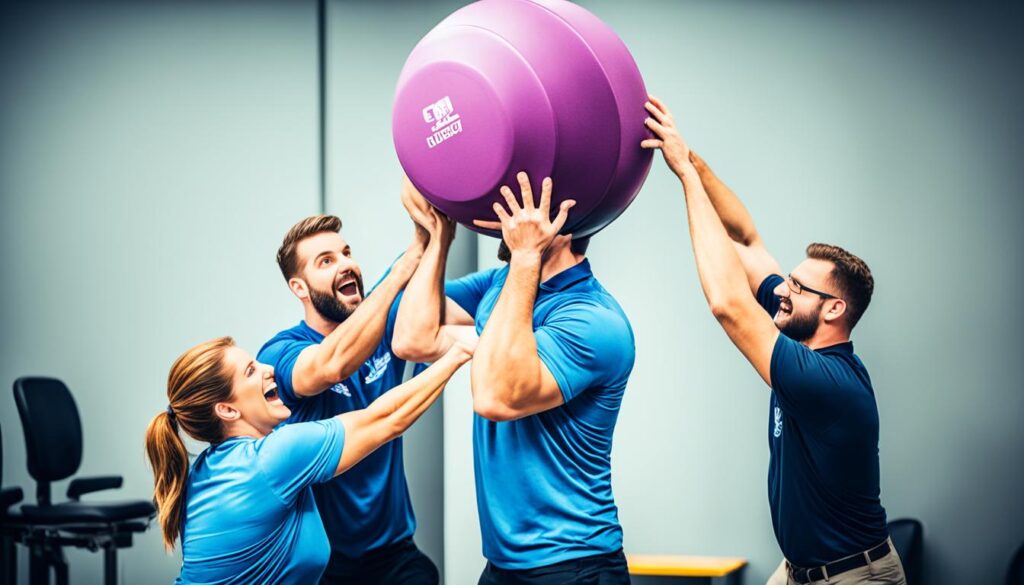Team dynamics play a critical role in shaping the success of a workplace. Effective teamwork and group collaboration results in enhanced creativity, productivity, and overall effectiveness. By understanding the importance of team dynamics and actively working to improve them, organizations can unlock a multitude of benefits.
Key Takeaways:
- Positive team dynamics lead to improved work outcomes, customer satisfaction, and a stronger bottom line.
- Poor team dynamics, such as weak leadership, deference to authority, blocking, groupthink, freeriding, and evaluation apprehension, can hinder collaboration and productivity.
- Strategies for improving team dynamics include getting to know your team, providing quick feedback, clarifying roles and responsibilities, breaking down barriers, and fostering effective communication.
- Building trust and communication through team bonding activities enhances problem-solving, idea generation, and overall teamwork.
- Leadership plays a crucial role in shaping team dynamics through understanding individual roles, providing constructive feedback and support, and addressing underperformance and accountability.
By fostering positive team dynamics through clear goals, open communication, diversity and inclusion, and team building activities, organizations can cultivate a productive work environment and a cohesive, high-performing team. Investing in effective team dynamics is key to achieving collaboration and fostering a positive company culture.
Why Having Good Team Dynamics Is Important
Having good team dynamics is crucial for the success and effectiveness of any company. Poor team dynamics can lead to weak leadership, deference to authority, blocking behavior, groupthink, freeriding, and evaluation apprehension, among other negative outcomes. On the other hand, positive team dynamics bring numerous benefits to the operation of an organization.
Improved Results: Positive team dynamics promote collaboration, cooperation, and effective problem-solving, resulting in improved outcomes and performance.
Greater Collaboration: When team members have good dynamics, they are more willing to share ideas and insights, leading to enhanced creativity, innovation, and better decision-making processes.
Faster Decision-Making: Trust and open communication within the team can speed up the decision-making process, allowing for quicker responses to challenges and opportunities.
Greater Commitment: Positive team dynamics foster a sense of belonging and ownership, encouraging team members to be more committed and dedicated to achieving shared goals.
To illustrate the importance of team dynamics, consider this quote from Steve Jobs, co-founder of Apple:
“Great things in business are never done by one person; they’re done by a team of people.”
– Steve Jobs
Strategies for Improving Team Dynamics
Improving team dynamics is essential for creating a collaborative and high-performing team. By implementing effective strategies, managers can optimize teamwork and drive better outcomes. Here are some key strategies for improving team dynamics: Encouraging open communication is a fundamental step in fostering trust and understanding among team members. Additionally, establishing clear roles and responsibilities can help prevent conflicts and ensure everyone is on the same page. By incorporating boosting team collaboration strategies, managers can further enhance synergy among team members, leading to more innovative solutions and improved overall performance.
1. Know Your Team
Understanding the individuals in your team is crucial for building strong dynamics. Take the time to get to know each team member’s strengths, weaknesses, and working styles. This knowledge will help you assign tasks and responsibilities more effectively, ensuring that everyone’s skills are utilized optimally.
2. Provide Quick Feedback
Timely feedback is vital for addressing poor behavior and improving team dynamics. Regularly communicate both positive reinforcement and constructive criticism to foster growth and development. By providing prompt feedback, you can address issues before they escalate and ensure a positive working environment.
3. Define Roles and Responsibilities
Clear roles and responsibilities within the team help manage dynamics and prevent confusion. Each team member should have a defined role that aligns with their skills and expertise. This clarity promotes accountability and minimizes conflicts arising from overlaps or gaps in responsibilities.
4. Break Down Barriers
Destructive barriers, such as lack of trust or communication breakdowns, can hinder team dynamics. Engage in team building activities that encourage collaboration, trust, and open communication. These activities can help break down barriers and foster a positive team environment.
“Teamwork is the ability to work together toward a common vision. It is the fuel that allows common people to attain uncommon results.” – Andrew Carnegie
5. Enhance Communication
Effective communication is the cornerstone of successful team dynamics. Foster an environment where team members feel comfortable sharing their ideas and concerns openly. Encourage active listening, respect diverse perspectives, and promote transparent communication channels to foster a culture of trust and collaboration.
Implementing these strategies will strengthen team dynamics, improve collaboration, and achieve better results. By investing time and effort into improving team dynamics, managers can create a positive and productive work environment.

Key Points:
- Know your team members and understand their strengths and weaknesses.
- Provide quick feedback to address poor behavior promptly.
- Create clear roles and responsibilities to manage dynamics effectively.
- Break down barriers through team building activities.
- Promote effective communication to foster trust and collaboration.
Building Trust and Communication in Team Dynamics
Team bonding activities are essential for promoting trust and open communication among team members. These activities create opportunities for team members to connect on a personal level and foster a sense of camaraderie. Through shared experiences and collaboration, team bonding activities help build trust, which is crucial for effective teamwork.
Trust is the foundation of strong team dynamics. It allows team members to feel safe expressing their opinions, sharing ideas, and taking risks without the fear of judgment or criticism. When trust exists within a team, communication flows more freely, leading to improved problem-solving and idea generation.
During team bonding activities, team members are encouraged to work together towards a common goal. This collaborative environment enhances teamwork skills and boosts creativity. By engaging in problem-solving exercises and brainstorming sessions, team members learn how to effectively collaborate and leverage each other’s strengths.
Team bonding activities create an atmosphere of shared purpose, fostering collaboration and creativity. They provide an opportunity for team members to step outside their usual roles and develop a deeper understanding of each other’s perspectives. This increased understanding leads to better communication and problem-solving within the team.
By reducing conflict and improving productivity, team bonding activities contribute to a positive work environment. These activities address underlying tensions and promote healthy communication, preventing conflicts from escalating. When team members can trust and communicate effectively with one another, they can overcome challenges more efficiently, resulting in increased productivity.
Another significant benefit of team bonding activities is the boost to employee morale and retention. When team members feel connected and valued, they are more likely to be satisfied with their work and remain committed to the organization. This, in turn, improves employee retention rates and reduces turnover, leading to a more stable and cohesive team.
To sum up, team bonding activities play a vital role in building trust and communication within team dynamics. They enhance collaboration, problem-solving, and idea generation, while also reducing conflict and improving productivity. Moreover, these activities boost employee morale and retention, contributing to a positive and harmonious work environment.
The Role of Leadership in Team Dynamics
Leadership plays a crucial role in team dynamics. Effective leaders understand the importance of individual roles and responsibilities within the team. By providing clear guidance and direction, leaders can ensure that each team member understands their specific tasks and how they contribute to the overall goals of the team. This understanding helps create a sense of purpose and motivation among team members, leading to increased productivity and collaboration.
In addition to clarifying roles, effective leaders also provide constructive feedback and support to help team members grow and develop their skills. They recognize and acknowledge the strengths of each individual and provide guidance for improvement in areas that may need development. By fostering a culture of continuous learning and improvement, leaders can build a high-performing team that consistently delivers exceptional results.
Addressing underperformance and holding team members accountable are also crucial aspects of leadership in team dynamics. Leaders must confront underperformance promptly and provide the necessary guidance and resources to help team members improve. By setting clear expectations and holding individuals accountable for their actions and outcomes, leaders establish a culture of responsibility and ensure that team members are held to a high standard of performance.
In summary, leadership is essential for fostering positive team dynamics. Effective leaders understand the individual roles and responsibilities of team members, provide constructive feedback and support, and address underperformance to promote a culture of accountability and growth within the team.

Best Practices for Fostering Positive Team Dynamics
In order to foster positive team dynamics, it is essential to implement a set of best practices that encourage collaboration, trust, and inclusivity within the team. By following these strategies, teams can enhance their performance and achieve their goals effectively. Here are some key practices to promote positive team dynamics:
- Establish Clear Goals and Expectations: Clearly define the team’s objectives and ensure that every team member understands their role in achieving those goals. This clarity helps to motivate and align the team towards a common purpose.
- Encourage Open Communication and Trust: Create a supportive environment where team members feel comfortable sharing their ideas, concerns, and feedback. Open communication fosters trust and allows for constructive collaboration.
- Promote Diversity and Inclusion: Embrace and value the diverse perspectives, backgrounds, and experiences within the team. Promoting diversity and inclusion leads to a broader range of ideas, increased innovation, and a positive work environment.
- Engage in Team Building Activities: Plan and participate in team building activities that promote collaboration, communication, trust, and mutual respect. These activities can range from team retreats to problem-solving exercises or even social events that allow team members to bond and build stronger connections.
By adopting these best practices, organizations can create a conducive environment that fosters positive team dynamics and maximizes the potential of their teams.
“Fostering positive team dynamics is essential for driving innovation and achieving success. By establishing clear goals and expectations, encouraging open communication and trust, promoting diversity and inclusion, and engaging in team building activities, organizations can create a cohesive and high-performing team.”
Conclusion
Effective team dynamics play a critical role in the success of any organization. The benefits that stem from positive collaboration and a cohesive team are manifold. By fostering effective team dynamics, companies can witness significant improvements in collaboration, creativity, and productivity. Moreover, when team members feel supported and valued, they are more likely to contribute innovative ideas and solutions, leading to enhanced problem-solving capabilities. This atmosphere of trust and open communication also helps in mitigating conflicts, allowing teams to navigate challenges more efficiently. Ultimately, understanding the essentials of team collaboration ensures that all members are aligned toward common goals, maximizing the potential for collective success.
One of the key advantages of promoting strong team dynamics is the creation of a positive company culture. A positive culture is essential to inspire and motivate employees, leading to increased morale and a greater sense of unity. With a united team fueled by positive dynamics, organizations are better equipped to tackle challenges and achieve their desired outcomes.
To achieve effective team dynamics, it is crucial for organizations to prioritize and implement best practices. This includes establishing clear goals and expectations, fostering open communication, promoting diversity and inclusion, and engaging in team building activities. By strategizing and investing in team dynamics, organizations can reap the rewards of improved collaboration, enhanced creativity, and a positive work environment.
In conclusion, effective team dynamics are the backbone of a successful organization. By prioritizing collaboration, nurturing a positive company culture, and implementing best practices, companies can unlock the full potential of their teams and drive overall performance to new heights.
FAQ
What are the benefits of improving team dynamics?
Improving team dynamics can lead to better work outcomes, customer satisfaction, and an improved bottom line. It can also result in improved results, greater collaboration, faster decision-making, and greater commitment from team members.
What are the characteristics of poor team dynamics?
Poor team dynamics are characterized by weak leadership, deference to authority, blocking behavior, groupthink, freeriding, and evaluation apprehension.
What strategies can be used to improve team dynamics?
Managers can improve team dynamics by getting to know their team, understanding group development phases, providing quick feedback, creating clear roles and responsibilities, breaking down barriers, and promoting effective communication.
How do team bonding activities contribute to team dynamics?
Team bonding activities build trust and open communication among team members. They enhance problem-solving and idea generation, reduce conflict, improve productivity, and boost employee morale and retention.
What is the role of leadership in team dynamics?
Effective leaders understand individual roles and responsibilities within the team, provide constructive feedback and support, and address underperformance and hold team members accountable.
What are the best practices for fostering positive team dynamics?
Best practices for fostering positive team dynamics include establishing clear goals and expectations, encouraging open communication and trust, promoting diversity and inclusion, and engaging in team building activities.
What are the benefits of effective team dynamics?
Effective team dynamics lead to improved collaboration, creativity, and productivity. They foster a positive company culture and increase employee morale.


